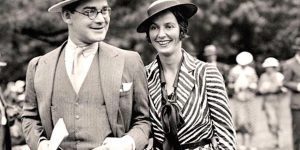The British 1930s Fashion was a decade defined by important historical and cultural events that had a tremendous influence on people’s lives and fashion choices in the United Kingdom. Despite the fact that it occurred almost a century ago, the era’s classic style and elegance continue to attract and inspire current designers and fashion fans alike. The Great Depression, Hollywood glamour, and Art Deco design were just a few of the influences on the fashion of the time, resulting in a distinct combination of pragmatism, elegance, and glamour.
We’ll look at the essential features of 1930s British fashion, from shapes and materials to the accessories that marked the era, in this post. We will also look at some of the most notable people in British fashion in the 1930s and their long-term effects on the industry.
Finally, we’ll look at how the allure of 1930s British design has been resurrected in current fashion and offer advice on how to incorporate 1930s-inspired pieces into a modern wardrobe. Join us as we go back in time to an age of beauty and flair that continues to enchant fashion enthusiasts today.
I. Historical and Cultural Context
The historical and cultural environment of the British 1930s Fashions in the United Kingdom had a profound impact on the era’s fashion. The 1929 Great Depression had a significant influence on people’s lifestyles and dress choices. Many people were compelled to tighten their belts and make do with what they had, which resulted in a fashion trend towards pragmatism and frugality. As a result, the “make do and mend” culture grew in popularity, with individuals recycling and mending their old apparel rather than purchasing new pieces.

Simultaneously, Hollywood glamour and Art Deco style were gaining popularity, and these influences found their way into British 1930s Fashion. The glamour of Hollywood icons such as Greta Garbo and Marlene Dietrich, as well as the attraction of the silver screen, had a huge effect on women’s design. Bias-cut dresses and skirts, slinky satin gowns, and figure-hugging suits were fashionable, and the use of luxury textiles such as silk, velvet, and fur added to the era’s glitz.
Another significant impact on British 1930s Fashion was Art Deco, with its clean lines, geometric designs, and vibrant colors. The modernity and sleekness of the style were represented in fashion through the use of streamlined forms and strong, graphic patterns.
Finally, the emergence of fascism in Europe in the late 1930s influenced fashion. When World War II broke out in 1939, clothing rationing and a return to practical, utilitarian fashion ensued.
In summation, British 1930s Fashion was a complicated blend of pragmatism, glamour, and modernity, with influences from Hollywood, Art Deco, and the impending prospect of war all having a role in influencing the era’s fashion.
II. Key Elements of 1930s Fashion
The 1930s in Britain was a time of elegance and sophistication, and this was reflected in the era’s fashion. Here are some of the key elements that defined 1930s British fashion:
Silhouettes:
The silhouette of the British 1930s Fashion is characterized by a slim, elongated shape that emphasized the natural waistline. Men’s suits were tailored with a strong shoulder and a tapered waist, while women’s clothing featured bias-cut dresses that clung to the body and flared out at the hem.
Fabrics:
Luxurious fabrics like silk, satin, and velvet were popular in the 1930s, as were lightweight materials such as chiffon and organdy. Wool was also widely used, especially in men’s suits, and tweed became popular for country wear.
Colors:
The color palette of the 1930s was influenced by Art Deco, with bold, contrasting colors like black and white, navy and ivory, and emerald green and ruby red. Soft pastel shades like peach, mint green, and powder blue were also popular.
Prints:
Geometric patterns, such as zigzags, chevrons, and stripes, were popular in the 1930s, as were floral prints and Art Deco-inspired designs.
Accessories:
Accessories were an important part of British 1930s Fashion, with gloves, hats, and jewelry used to complete the look. Gloves were especially popular and came in a variety of lengths and styles, while hats ranged from cloches to wide-brimmed styles.
Shoes:
Women’s shoes in the 1930s featured high heels and rounded toes, often with T-straps or ankle straps. Men’s shoes were typically oxfords or brogues, with a sturdy leather sole.
Overall, the key elements of British 1930s Fashion were practicality, sophistication, and glamour. The use of luxurious fabrics and bold patterns, along with the emphasis on a slim, elongated silhouette, created a look that was both elegant and modern.
III. Icons of 1930s British Fashion
The 1930s in Britain produced some of the most iconic figures in fashion history, whose influence can still be seen today. Here are some of the key figures who defined 1930s British fashion:
Wallis Simpson:
Wallis Simpson, the American socialite who later became the Duchess of Windsor, was a fashion icon of the 1930s. Known for her impeccable style and love of luxury, she favored bias-cut dresses, fur-trimmed coats, and statement jewelry.
Elsa Schiaparelli:
The Italian fashion designer Elsa Schiaparelli was a major influence on 1930s fashion, with her use of bold, graphic prints and surrealist-inspired designs. She collaborated with artists like Salvador Dali and Jean Cocteau to create unique and imaginative clothing and accessories.
Vivien Leigh:
Vivien Leigh, the British actress best known for her roles in “Gone with the Wind” and “A Streetcar Named Desire,” was a style icon of the 1930s. Her elegant and sophisticated look, with bias-cut gowns and tailored suits, captured the glamour of the era.
Queen Elizabeth (the Queen Mother):
Queen Elizabeth, the Queen Mother, was a major style icon of the 1930s, known for her chic and practical clothing choices. She popularized the tailored coat and skirt suit and was often seen wearing hats and gloves to complete her look.
Fred Astaire:
Fred Astaire, the American dancer, and actor, was a style icon of the 1930s, with his impeccable taste in tailored suits and elegant evening wear. He popularized the double-breasted suit and the bow tie, and his dancing inspired a trend for more relaxed, comfortable clothing for men.
These figures, among others, helped to define the look and feel of 1930s British fashion, and their influence can still be seen in contemporary fashion today.
IV. Reviving 1930s British Fashion Today
The elegance and sophistication of 1930s British fashion continue to inspire designers and fashion enthusiasts today. Here are some ways to incorporate the style of the era into your wardrobe:
Slim Silhouettes:
The slim, elongated silhouette of 1930s fashion can be recreated with tailored pieces that emphasize the waistline. Look for dresses and trousers with a high waist and tapered legs, and pair them with a cropped jacket or a fitted blouse.
Luxe Fabrics:
Embrace the luxurious fabrics of the era, such as silk, satin, and velvet, in modern cuts and styles. Try a velvet blazer or a satin slip dress, or incorporate a touch of silk with a scarf or a blouse.
Bold Colors and Prints:
Experiment with bold, contrasting colors like black and white, or jewel tones like emerald green and sapphire blue. Geometric prints and Art Deco-inspired designs can add a touch of vintage flair to your look.
Accessories:
Incorporate accessories like gloves, hats, and statement jewelry to complete your 1930s-inspired look. Try a pair of long gloves with a sleeveless dress, or a cloche hat with a tailored suit. Chunky jewelry or a statement brooch can add a touch of glamour.
Shoes:
Look for shoes with rounded toes and high heels for a 1930s-inspired look. T-strap or ankle-strap heels are a great choice for a vintage feel, while oxford or brogue-style shoes can add a touch of menswear-inspired sophistication.
Overall, 1930s British fashion offers a timeless elegance and sophistication that can be incorporated into modern wardrobes. By choosing key elements like slim silhouettes, luxe fabrics, bold colors and prints, and statement accessories, anyone can revive the charm of 1930s fashion today.
V. Conclusion
Finally, in the British 1930s Fashion was a moment of refinement, glamour, and sophistication. Slim shapes, sumptuous fabrics, and vibrant colors and designs defined the era, which was exemplified by legendary people such as Wallis Simpson, Elsa Schiaparelli, Vivien Leigh, Queen Elizabeth (the Queen Mother), and Fred Astaire. Today, the allure of 1930s fashion inspires designers and fashion enthusiasts alike, providing a timeless look that can be incorporated into modern wardrobes. Anyone can capture the glamour and sophistication of the 1930s era and add a touch of vintage charm to their wardrobe by reviving key elements of 1930s fashion.
